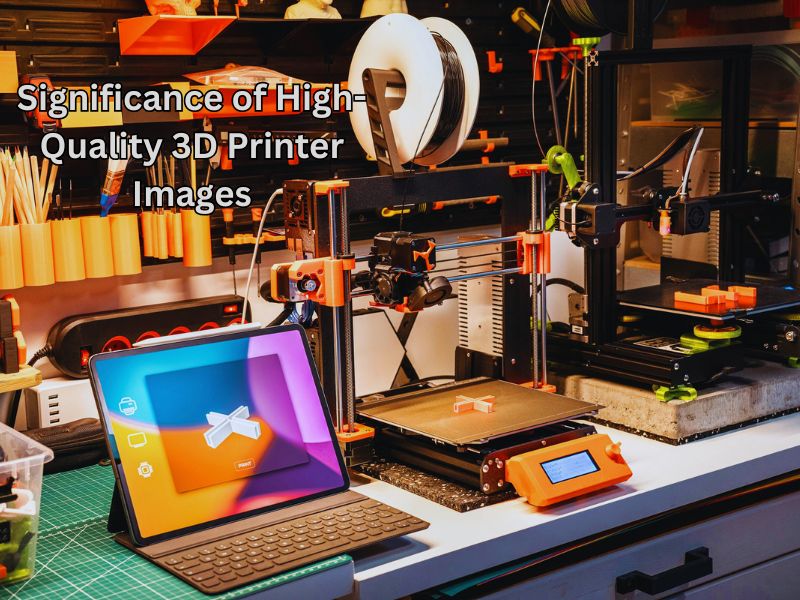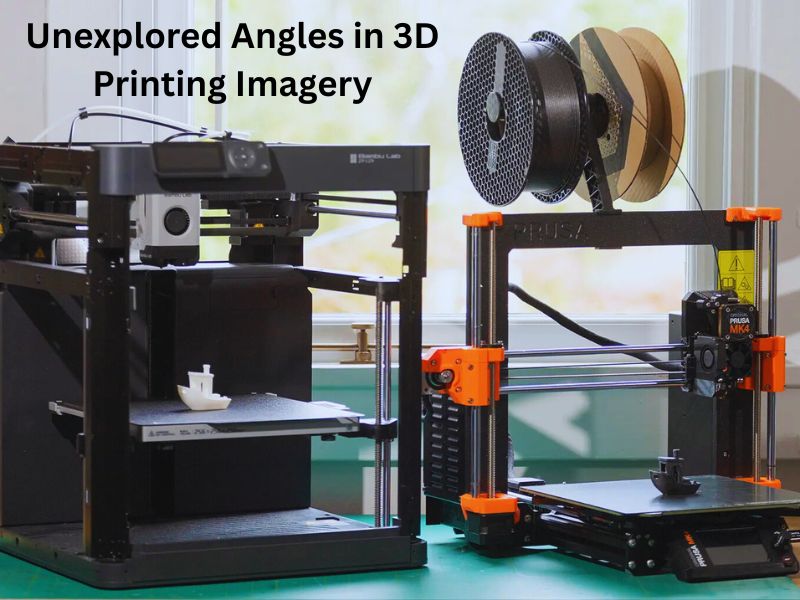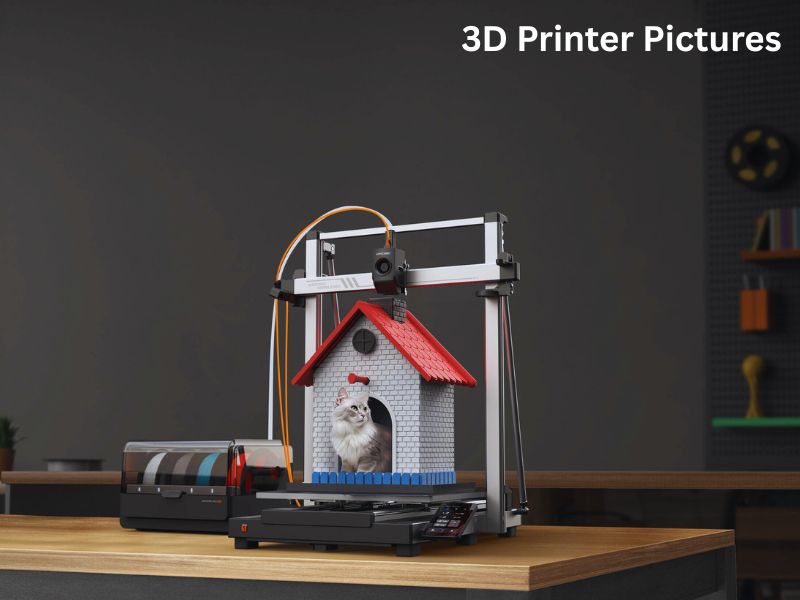High-quality 3D printer pictures are transforming how we perceive and utilize additive manufacturing. These visuals not only showcase the intricate details of printed objects but also highlight the technological advancements in the printing field.
With over two decades in 3D printing, I’ve witnessed its evolution from basic prototypes to complex, functional designs. Today, the clarity and precision of 3D printed images play a pivotal role in various industries, from healthcare to aerospace. Whether showcasing industrial machines or the best 3d printer for small business, these visuals highlight the true capabilities of modern printers. They serve as a bridge between digital designs and tangible products, offering deep insights into the advancements of 3D printing technology.
This article examines the importance of high-quality 3D printer images, exploring their influence on design, production, and the future of manufacturing.

Understanding the Significance of High-Quality 3D Printer Images
High-quality 3D printer pictures showcase the precision and complexity of printed objects. They reveal fine details, such as sharp edges, intricate patterns, and clean surfaces. These images help audiences appreciate the craftsmanship behind modern 3D printing.
3D printer pictures also highlight material textures and finishes. Whether it’s a glossy resin or a matte PLA filament, good visuals capture these subtle differences, helping designers and engineers choose the right materials.
For businesses, strong 3D printer pictures attract clients and investors by demonstrating technical skills and innovation. They build trust and spark interest across websites, brochures, and social media.
In education, clear 3D printer pictures make complex topics easier to understand. Students can visualize 3D models more effectively, leading to stronger learning experiences in fields such as biology and engineering.
Technological Advancements Elevating 3D Printing Imagery
Integration of AI and Machine Learning in 3D Printing
AI is optimizing 3D printing designs, creating complex yet efficient geometries that result in 3D printer images with intricate details. Machine learning enhances print quality and consistency, resulting in smoother surfaces and more accurate 3D printer output, which accurately reflects the true potential of the printed objects.
Emergence of Multi-Material and Multi-Color Printing
Multi-material and multi-color printing allow for the creation of objects with varying properties in a single print. This innovation enhances 3D printer pictures, making them more vibrant and informative. Using different colors helps convey a design’s functionality, enriching the visual experience.
High-Speed 3D Printing: Reducing Time Without Compromising Quality
High-speed 3D printers, such as Formlabs’ Form 4, offer faster print times without compromising quality. This enables rapid production and quicker iterations, while maintaining the clarity and detail of 3D printer images, ensuring both efficiency and precision in visual representation.

Exploring the Future: Trends Shaping 3D Printing Imagery
Bioprinting: Visualizing the Convergence of Biology and Technology
Creation of Tissues and Organs and Their Representation Through Images
Bioprinting is revolutionizing medicine by enabling the creation of complex tissue structures. High-resolution images of these bioprinted tissues are essential for understanding their viability and integration within biological systems.
Ethical Considerations and the Role of Visuals in Public Perception
Images of bioprinted tissues play a significant role in shaping public perception of bioprinting’s ethical implications. Visuals help facilitate discussions about the future of biotechnology and its societal impact.
Sustainable 3D Printing: Showcasing Eco-Friendly Innovations
Use of Biodegradable and Recycled Materials in Printing
The 3D printing industry is embracing sustainable materials, such as PLA, which is biodegradable and made from renewable resources. Additionally, recycled plastics are being used to promote a circular economy.
Visual Documentation of Sustainable Practices and Their Outcomes
Photographs and diagrams highlighting eco-friendly practices in 3D printing help raise awareness and encourage the use of sustainable methods within the industry.
Large-Scale 3D Printing: From Homes to Infrastructure
Projects Like 3D-Printed Houses and Their Photographic Documentation
Large-scale 3D printing is revolutionizing the construction industry, with projects such as 3D-printed homes offering affordable housing solutions. Photographs of these projects showcase the potential and efficiency of 3D printing in the construction industry.
Challenges and Solutions in Capturing Large-Scale Prints
Capturing large-scale 3D prints is challenging due to their size and complexity. Photographers employ techniques such as drone photography and panoramic imaging to accurately document these massive projects.
Certainly! Here’s a table summarizing the key trends shaping 3D printing imagery in 2024 and beyond:
Summarize
| Trend | Description | Impact on 3D Printing Imagery |
| Sustainable Materials | Adoption of eco-friendly materials like PLA+, recycled plastics, and biodegradable filaments. | Enhances the visual appeal of prints with natural textures and colors, aligning with environmental aesthetics. |
| AI-Driven Design Tools | Integration of AI and machine learning in design software for optimizing structures and aesthetics. | Enables the creation of complex, visually striking designs with improved efficiency and accuracy. |
| Multi-Material Printing | Printing with multiple materials simultaneously to achieve varied textures and functionalities. | Allows for more dynamic and colorful prints, offering a richer visual experience. |
| 4D Printing | Objects that change shape or properties over time in response to environmental stimuli. | Introduces motion and transformation in printed objects, adding a dynamic element to visual representations. |
| Volumetric Printing | Creating full-color, auto-stereoscopic 3D images through the scattering of light in a volume of pigment. | Produces hologram-like visuals that can be viewed from multiple angles without the need for special glasses, thereby enhancing interactive displays. |
| On-Demand and Localized Printing | Decentralized production allows for localized and customized printing. | Facilitates the creation of personalized imagery and products tailored to specific local tastes and preferences. |
| Integration with Industry 4.0 | Combining 3D printing with IoT, robotics, and real-time data analytics. | Streamlines the production of imagery, ensuring consistency and quality control in large-scale printing operations. |
| Educational Applications | Incorporation of 3D printing in educational settings for hands-on learning. | Promotes creativity and innovation in visual design among students and educators, resulting in a diverse range of 3D-printed imagery. |
These trends are collectively transforming the landscape of 3D printing imagery, making it more sustainable, dynamic, and accessible.

Unique Perspectives: Unexplored Angles in 3D Printing Imagery
3D Printing in Space: Documenting Extraterrestrial Manufacturing
NASA’s lunar and Martian 3D printing initiatives are exploring ways to construct habitats, landing pads, and roads using local materials. Visuals of these projects are crucial for understanding the complexities of manufacturing in space, especially in microgravity and with extraterrestrial resources. A 3D Picture Printer Turns Memories into detailed visuals that help illustrate these efforts. High-quality images provide valuable insights into these challenges and offer educational benefits, helping the public understand the scale and importance of off-Earth manufacturing.
Volumetric and Dynamic Interface Printing: A New Visual Frontier
GRACE and DIP: Advanced 3D Printing Techniques
- GRACE (Generative, Adaptive, Context-Aware 3D Printing) creates complex structures with minimal user input by adapting to environmental features.
- DIP (Dynamic Interface Printing) uses acoustic modulation for rapid printing, eliminating the need for intricate systems while maintaining speed and precision.
Capturing the Nuances Through Imagery
Visual documentation of GRACE and DIP highlights their advanced capabilities, showcasing the intricate details of the structures they produce. High-resolution images make these technologies more accessible and inspire innovation across various industries, including healthcare and aerospace.
Practical Guide: Capturing High-Quality Images of 3D Prints
Essential Equipment for Optimal Photography
Recommended Cameras and Lenses
- DSLR or Mirrorless Cameras: Opt for models with manual settings for precise control over exposure and focus.
- Prime Lenses: A 50mm lens offers sharp, distortion-free images, making it an ideal choice for capturing 3D prints.
Lighting Setups
- Softbox Lighting: Diffuses light evenly, minimizing harsh shadows and highlighting details.
- Light Tent: Provides consistent lighting and background, ensuring high-quality product shots.
Backgrounds and Staging
- Neutral Backgrounds: Stick to plain white or gray to keep the focus on the print.
- Stabilization Tools: Use a tripod to minimize camera shake, ensuring sharp, stable images.
Tips for Achieving the Best Angles and Highlights
- Multiple Angles: Shoot from different perspectives to showcase the print’s features.
- Side Lighting: Position lights at 45-degree angles to highlight textures.
- Macro Shots: Utilize macro lenses for detailed, close-up shots of intricate features.
- Depth of Field: Adjust aperture settings to keep the entire print in focus.
Post-Processing Techniques to Enhance Visual Appeal
Editing Software Suggestions
- Adobe Photoshop: Ideal for color correction and enhancing fine details.
- Lightroom: Perfect for adjusting exposure, contrast, and sharpness.
- GIMP: A free alternative with robust editing tools.
Balancing Authenticity with Aesthetic Enhancements
- Color Accuracy: Maintain true colors to reflect the actual print.
- Highlight Details: Enhance textures without over-editing.
- Consistent Lighting: Ensure uniform lighting across multiple images.

High-quality images of 3D prints are more than just photographs; they are windows into the future of manufacturing. As industries such as fashion, healthcare, and aerospace adopt 3D printing, the demand for clear, detailed visuals increases. These images not only showcase the precision and innovation of 3D printing but also inspire further advancements and applications. In a world where first impressions matter, capturing the essence of 3D prints through high-quality photography is essential. By investing in the right equipment and techniques, we can ensure that the story of 3D printing is told with clarity and impact.
Frequently Asked Questions
What exactly is a lithophane, and how does it work?
A lithophane is a 3D print of a photo that uses the thickness of the print to show varying shades of grey when illuminated from behind. Put simply, lithophanes are a way of displaying an image by backlighting a piece of somewhat translucent material.12 The magic of a lithophane lies in its varying thicknesses. When light passes through the lithophane, the thicker parts block more light, appearing darker, while the thinner areas allow more light to pass through, appearing lighter.
What kind of photos work best for lithophanes?
The 3D-printed photo will appear in shades of grey, so if there is any important detail that requires color, the image may not be a good fit. It is best to choose a picture with a reasonably high contrast ratio. An image with a lot of details might not look as good as a lithograph, so a simple image with a uniform background would be better. Generally, the simpler a picture is, the better the resulting model. It is essential that the source image has clearly defined colors and that the transition between them is distinct and not gradual.
What layer height should I use for lithophanes?
When dealing with a 3D print, it’s advisable to look for a neutral and simple background. Your photos are often the first interaction a buyer has with your product. Invest in good lighting and use a clean, uncluttered background to highlight your creations. Include multiple angles and close-ups to showcase details, especially for intricate 3D-printed items, such as jewelry or gaming miniatures.
What background should I use for photographing 3D prints?
One of the most critical parameters in determining the quality of your final lithophane is the layer height. The coarsest you can go without the lithophane looking too bad will be roughly 0.2 mm layer height. However, for more detailed lithophanes, as with print speed, the lower you go, the better it will be for the quality of the lithophane. We use a layer height of 0.12 mm, which is a sweet spot for us, balancing quality and the time it takes to print a lithophane.
What’s the best filament color for lithophanes?
The most commonly used material for lithophane printing is PLA (Polylactic Acid) because of its ease of use and good light diffusion properties. For best results, use a light-colored or white PLA, as it provides better contrast when illuminated. Another essential detail is to use a white or natural filament. You can also experiment with some light colors, such as yellow, but since the image will be sort of black & white, it is best to use white as the filament.
What software should I use to convert photos to lithophanes?
To generate a 3D model, convert your picture into a Lithophane. There are options available: Cura or Image to Lithophane. I’ve tested Cura, It’s Litho, 3D Rocks, and Lithophane Maker. Cura can make a lithophane by just loading a JPG. Lithophane Maker is a more efficient program and indeed runs faster. It’s currently supported and has a Facebook community where you can discuss the topic further.
Can I create a 3D model from just one photo?
Did you know that you can create a 3D model even with a single picture? Don’t get too excited – creating a 3D model from photos is possible, but keep in mind that the possibilities and details allowed would be more limited. For example, you cannot expect to create a perfect 360° file of your pet or your home based on one picture.
